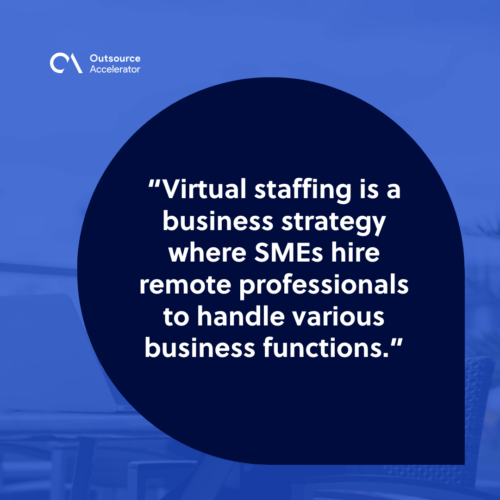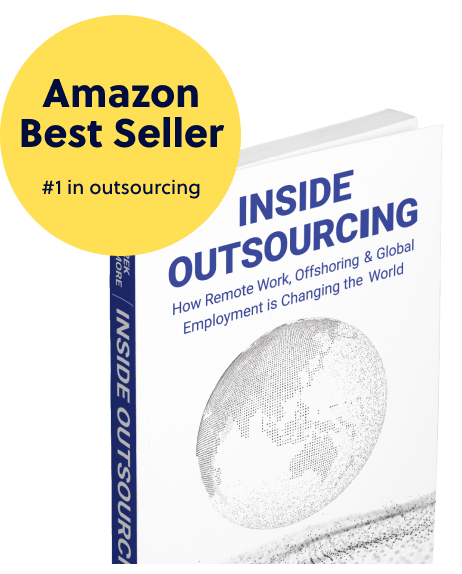Virtual staffing: A cost-effective solution for SMEs

We’re convinced: One of the most effective ways for small and medium-sized enterprises (SMEs) to stay agile and competitive is through virtual staffing.
By leveraging remote professionals from platforms like VirtualStaff.ph, SMEs can reduce costs, access a global talent pool, and maintain operational flexibility.
In this article, we’ll explore virtual staffing, how it compares to traditional hiring, how to implement it effectively, and why it’s a smart choice for growing businesses.
What is virtual staffing?
Virtual staffing is a business strategy where SMEs hire remote professionals to handle various business functions. These staff members work from different locations, often globally, and connect with the business through digital tools and communication platforms.
Virtual staff can perform a wide range of roles, including administrative support, customer service, IT, marketing, accounting, and more.

The appeal of virtual staffing lies in its ability to provide businesses with skilled professionals on a flexible basis. Whether a company needs full-time, part-time, or project-based support, virtual staffing offers a tailored approach to meet specific business needs.
Virtual staffing vs. Traditional hiring
These days, traditional hiring is starting to feel a bit old-school. With the rise of virtual staffing, more and more businesses are opting for remote teams. Still, some companies are sticking to what they know.
To see why virtual staffing is becoming so popular, let’s break down how it stacks up against traditional hiring:
| Feature | Virtual Staffing | Traditional Hiring |
| Cost Efficiency | Reduces office, equipment, and overhead costs | Requires investment in physical space and resources |
| Talent Access | Global talent pool, no geographic limitations | Limited to local candidates |
| Flexibility | Scalable workforce for seasonal or project-based needs | Fixed contracts, less adaptability |
| Speed of Hiring | Quick access to pre-vetted professionals | Lengthy recruitment and onboarding process |
| Operational Continuity | Ideal for remote work and handling disruptions | More vulnerable to local disruptions |
Why SMEs should consider virtual staffing
Aside from significant cost savings, virtual staffing offers numerous benefits that align well with the challenges and opportunities faced by SMEs.
Here’s a closer look at why this approach is worth considering:
Enhanced productivity and efficiency
With access to specialists and the ability to operate across different time zones, virtual staffing can boost efficiency.
SMEs can take advantage of a 24/7 work cycle, ensuring tasks are completed faster and allowing for quicker response times in customer service or project delivery.
Business continuity and resilience
Virtual teams are less impacted by local disruptions such as natural disasters, strikes, or office closures.
This flexibility allows businesses to maintain operations smoothly and reduces the risk of downtime.
Scalability and flexibility
Virtual staffing allows SMEs to scale their workforce up or down according to demand.
Whether it’s for seasonal work, special projects, or sudden business growth, virtual staffing provides the agility needed to adapt quickly without the complications of traditional hiring.
Strategic focus on core business activities
By delegating non-core or time-consuming tasks to virtual staff, business leaders can focus more on strategic goals. This helps enhance leadership efficiency, drive innovation, and improve overall business performance.
How to implement virtual staffing in your SME
Integrating virtual staffing into your SME’s operations can be a game-changer.
Here’s a short guide to help you get started:
Identify business needs
Determine which roles and tasks could be handled remotely. Common choices include administrative tasks, customer support, IT services, and content creation.

Set clear expectations
Define job roles, responsibilities, KPIs, and communication protocols. Clear guidelines help virtual staff align with business objectives from day one.
Monitor and manage
Regularly review performance, provide feedback, and keep communication channels open to ensure a productive and engaged remote team.
Most important step: Choose the right provider
Research and select a reputable virtual staffing provider that understands your industry and business needs. Look for providers with strong vetting processes and experience in managing remote teams – like
VirtualStaff.ph.
VirtualStaff.ph is not a typical job board: It’s the smarter way to build a remote team in the Philippines, with hiring, payroll & compliance all in one platform. Founded in 2016, the company has worked with 25,000 companies and provided jobs to up to one million professionals.
Connect with VirtualStaff.ph today to start building your dream remote team!







 Independent
Independent




